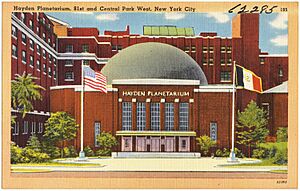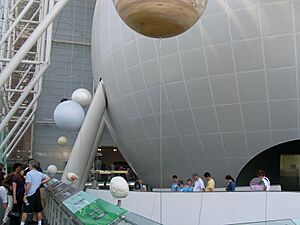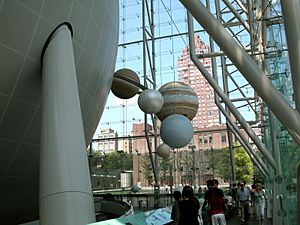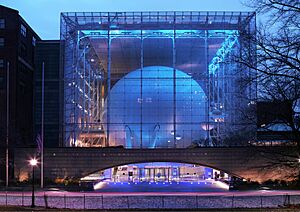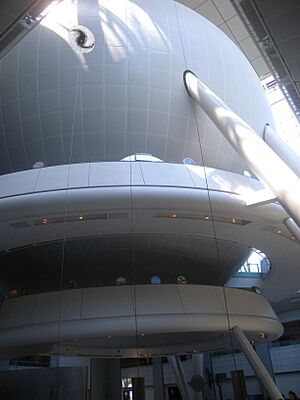Rose Center for Earth and Space facts for kids
 |
|
| Lua error in Module:Location_map at line 420: attempt to index field 'wikibase' (a nil value). | |
| Established | 1935 |
|---|---|
| Location | 75-208 79th Street Central Park West |
| Type | Natural history |
The Rose Center for Earth and Space is an exciting part of the American Museum of Natural History in New York City. Its full name is The Frederick Phineas and Sandra Priest Rose Center for Earth and Space. You can find its main entrance on the north side of the museum, on 81st Street near Central Park West in Manhattan's Upper West Side. The center opened in 2000 and includes the famous Hayden Planetarium, which first opened way back in 1935. Neil deGrasse Tyson has been its director since it opened.
Contents
Exploring the History of the Rose Center
The Rose Center is a big, new version of the old Hayden Planetarium. The original planetarium had several different projectors over the years before the current one was installed.
How the Hayden Planetarium Began
The first Hayden Planetarium was started in 1933. A kind banker named Charles Hayden gave money to help build it. It was designed by architects Trowbridge & Livingston and opened in 1935. The goal was to help people understand how huge the universe is and all the amazing things happening in it every day.
Over the years, the planetarium updated its equipment. In 1960, a new Zeiss Mark IV projector was added. Then, in 1993, a Zeiss Mark VI projector and new seats were installed.
The New Rose Center Opens
In January 1997, the old Hayden Planetarium closed down and was taken apart. A new, special Zeiss Mark IX projector was put in place in August 1999. This new system also included digital projectors that create amazing 3-D images of the universe. These images are made in real time by a powerful computer.
On February 19, 2000, the new Rose Center for Earth and Space opened to the public. It cost $210 million to build! The Rose Center was designed by James Polshek and Todd H. Schliemann. The first show in the new Hayden Planetarium had a voice-over by actor Tom Hanks. Since then, many other famous people like Whoopi Goldberg, Robert Redford, Harrison Ford, Liam Neeson and Maya Angelou have lent their voices to the shows.
Understanding the Design of the Rose Center
The building looks like a giant glass cube, about six stories tall. Inside this cube is the 87-foot (27 m) wide Hayden Sphere, which glows and looks like it's floating. It's actually held up by a hidden support structure. The designer, James Polshek, called it a "cosmic cathedral."
The Rose Center and the area around it are on the north side of the museum. The center has 333,500 square feet (30,980 m2; 3.098 ha) of space for research, learning, and exhibits. It also houses the Department of Astrophysics, which studies space and stars. There's also a special glass entrance called the Weston Pavilion. This structure offers a new way to enter the museum and more space for exhibits about space.
Pluto's Place in the Universe Exhibit
When the new Rose Center opened in 2000, its exhibits showed a model with only eight planets, not including Pluto. At that time, scientists were still discussing whether Pluto should be called a planet. Many people in America still thought of Pluto as the ninth planet. This decision by the museum caused a lot of discussion and media attention.
Exploring the Hayden Planetarium Sphere
The new Hayden Planetarium is often called "The Hayden Sphere" or "The Great Sphere." It's one of the two main attractions inside the Rose Center. The top part of the Hayden Sphere is the Star Theater. Here, high-resolution videos project amazing "space shows" that use real scientific data about space. There's also a special Zeiss Star Projector that shows an accurate night sky, just as you would see it from Earth.
The bottom half of the Hayden Sphere holds the Big Bang Theater. It has a screen 36 feet (11 m) across. A four-minute show here tells the story of how the universe began, with narration by Liam Neeson. This theater leads you to the Heilbrun Cosmic Pathway. This is a spiral ramp that wraps around the sphere, connecting the second and first floors. The Cosmic Pathway shows a timeline of the universe's history, from the Big Bang to today. It's one of the most popular exhibits at the Rose Center.
The Hayden Planetarium offers many different shows and presentations for visitors.
The Arthur Ross Terrace
The Arthur Ross Terrace is a large outdoor area next to the Rose Center. It's built over a parking garage. This rooftop plaza is designed to celebrate both astronomy and Earth's natural history. It's also a great place for museum visitors to gather outside. The design of the terrace was inspired by the shadows seen during a lunar eclipse.
Amazing Exhibits and Shows
As of 2019, five main shows have been shown in the planetarium theater.
- Passport to the Universe was the first show. It features the voice of Tom Hanks guiding you on a journey from Earth to the very edge of the observable universe.
- The Search for Life: Are We Alone? debuted in 2002. Harrison Ford narrates this show, exploring the chances of finding extraterrestrial life.
- Cosmic Collisions opened in 2006, narrated by Robert Redford. This show looks at how impacts have shaped the universe. It includes visuals of Earth's magnetosphere, how the Moon formed, and the meteorite impact that helped end the age of dinosaurs.
- Journey to the Stars, narrated by Whoopi Goldberg, premiered on July 4, 2009. It features incredible images from telescopes and stunning visualizations of space.
- Dark Universe, narrated by Neil deGrasse Tyson, premiered on November 2, 2013.
- Worlds Beyond Earth, narrated by Lupita Nyong'o, premiered on March 24, 2021. It tells the story of the exciting worlds in our Solar System and what makes life on Earth possible.
Other exhibits can be found outside the sphere. The Gottesman Hall of the Planet Earth shows displays about Earth's geological history and weather. The Cullman Hall of the Universe focuses on topics from planets and stars to life on other worlds. The Scales of the Universe exhibit compares the size of the Hayden Sphere to other objects in the universe, showing them at their correct relative sizes. There is also an exhibit with photographs from the Apollo Moon landings. These pictures are located throughout the first floor of the Rose Center.
See also
 In Spanish: Centro Rose para la Tierra y el Espacio para niños
In Spanish: Centro Rose para la Tierra y el Espacio para niños
- List of museums and cultural institutions in New York City
- Astronomy in New York City


